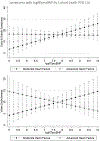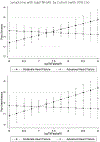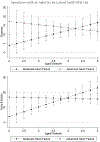Comparative symptom biochemistry between moderate and advanced heart failure
- PMID: 30314637
- PMCID: PMC6530561
- DOI: 10.1016/j.hrtlng.2018.09.002
Comparative symptom biochemistry between moderate and advanced heart failure
Abstract
Background: We have a limited understanding of the biological underpinnings of symptoms in heart failure (HF).
Objectives: The purpose of this paper was to compare relationships between peripheral biomarkers of HF pathogenesis and physical symptoms between patients with advanced versus moderate HF.
Methods: This was a two-stage phenotype sampling cohort study wherein we examined patients with advanced HF undergoing ventricular assist device implantation in the first stage, and then patients with moderate HF (matched adults with HF not requiring device implantation) in the second stage. Linear modeling was used to compare relationships among biomarkers and physical symptoms between cohorts.
Results: Worse myocardial stress, systemic inflammation and endothelial dysfunction were associated with worse physical symptoms in moderate HF (n=48), but less physical symptom burden in advanced HF (n=48).
Conclusions: Where patients are in the HF trajectory needs to be taken into consideration when exploring biological underpinnings of physical HF symptoms.
Keywords: Biomarkers; Heart failure; Symptoms.
Copyright © 2018. Published by Elsevier Inc.
Figures




References
-
- Yancy CW, Jessup M, Bozkurt B, et al. 2013 ACCF/AHA guideline for the management of heart failure: Executive summary: A report of the american college of cardiology foundation/american heart association task force on practice guidelines. Circulation. 2013;128(16):1810. doi: 10.1161/CIR.0b013e31829e8807. - DOI - PubMed
-
- Adams KF, Fonarow GC, Emerman CL, et al. Characteristics and outcomes of patients hospitalized for heart failure in the united states: Rationale, design, and preliminary observations from the first 100,000 cases in the acute decompensated heart failure national registry (ADHERE). Am Heart J. 2005;149(2):209–216. doi: 10.1016/j.ahj.2004.08.005. - DOI - PubMed
-
- Bekelman DB, Havranek EP, Becker DM, et al. Symptoms, depression, and quality of life in patients with heart failure. J Card Fail. 2007;13(8):643–648. doi: S1071-9164(07)00167-4 [pii]. - PubMed
Publication types
MeSH terms
Substances
Grants and funding
LinkOut - more resources
Full Text Sources
Medical
Research Materials
Miscellaneous

